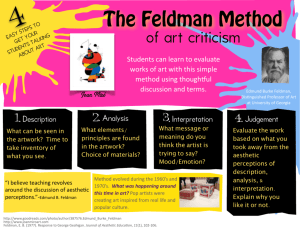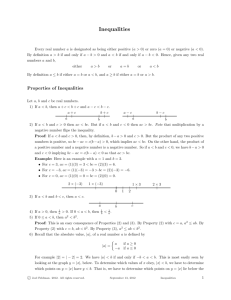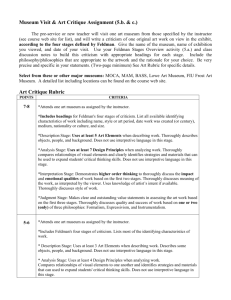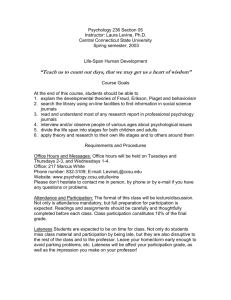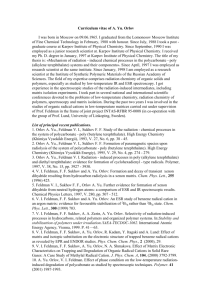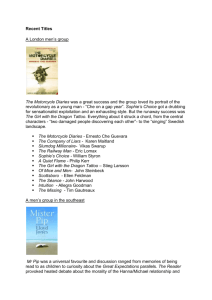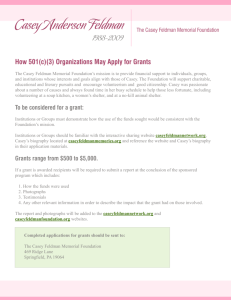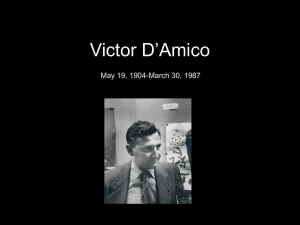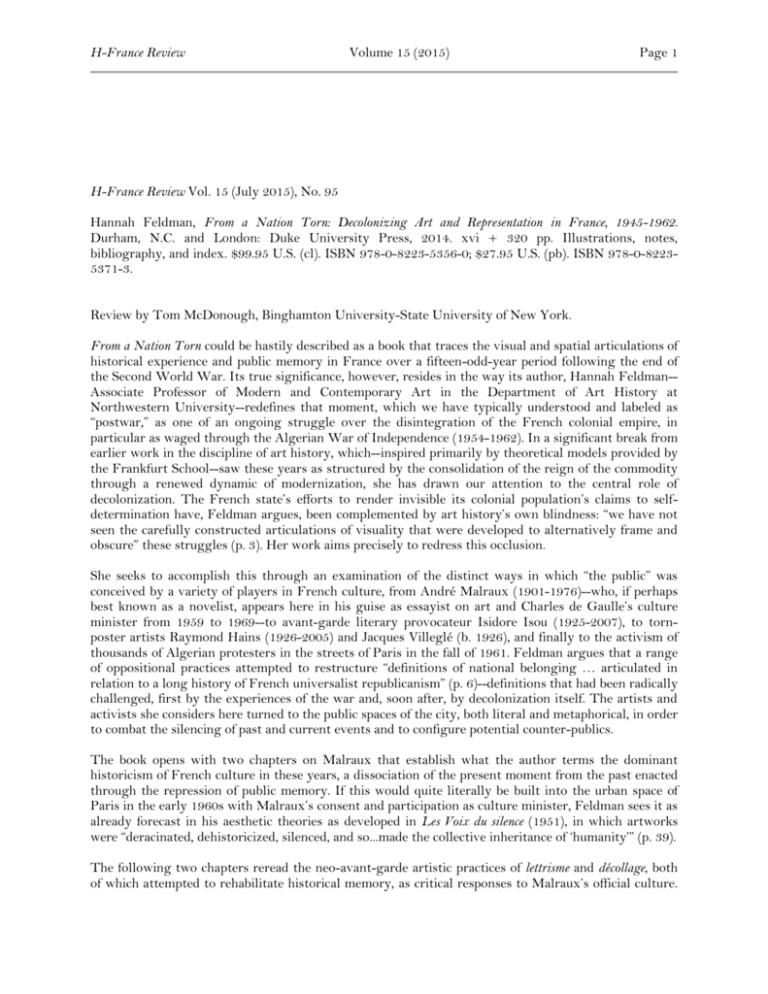
H-France Review
Volume 15 (2015)
Page 1
H-France Review Vol. 15 (July 2015), No. 95
Hannah Feldman, From a Nation Torn: Decolonizing Art and Representation in France, 1945-1962.
Durham, N.C. and London: Duke University Press, 2014. xvi + 320 pp. Illustrations, notes,
bibliography, and index. $99.95 U.S. (cl). ISBN 978-0-8223-5356-0; $27.95 U.S. (pb). ISBN 978-0-82235371-3.
Review by Tom McDonough, Binghamton University-State University of New York.
From a Nation Torn could be hastily described as a book that traces the visual and spatial articulations of
historical experience and public memory in France over a fifteen-odd-year period following the end of
the Second World War. Its true significance, however, resides in the way its author, Hannah Feldman-Associate Professor of Modern and Contemporary Art in the Department of Art History at
Northwestern University--redefines that moment, which we have typically understood and labeled as
“postwar,” as one of an ongoing struggle over the disintegration of the French colonial empire, in
particular as waged through the Algerian War of Independence (1954-1962). In a significant break from
earlier work in the discipline of art history, which--inspired primarily by theoretical models provided by
the Frankfurt School--saw these years as structured by the consolidation of the reign of the commodity
through a renewed dynamic of modernization, she has drawn our attention to the central role of
decolonization. The French state’s efforts to render invisible its colonial population’s claims to selfdetermination have, Feldman argues, been complemented by art history’s own blindness: “we have not
seen the carefully constructed articulations of visuality that were developed to alternatively frame and
obscure” these struggles (p. 3). Her work aims precisely to redress this occlusion.
She seeks to accomplish this through an examination of the distinct ways in which “the public” was
conceived by a variety of players in French culture, from André Malraux (1901-1976)--who, if perhaps
best known as a novelist, appears here in his guise as essayist on art and Charles de Gaulle’s culture
minister from 1959 to 1969--to avant-garde literary provocateur Isidore Isou (1925-2007), to tornposter artists Raymond Hains (1926-2005) and Jacques Villeglé (b. 1926), and finally to the activism of
thousands of Algerian protesters in the streets of Paris in the fall of 1961. Feldman argues that a range
of oppositional practices attempted to restructure “definitions of national belonging … articulated in
relation to a long history of French universalist republicanism” (p. 6)--definitions that had been radically
challenged, first by the experiences of the war and, soon after, by decolonization itself. The artists and
activists she considers here turned to the public spaces of the city, both literal and metaphorical, in order
to combat the silencing of past and current events and to configure potential counter-publics.
The book opens with two chapters on Malraux that establish what the author terms the dominant
historicism of French culture in these years, a dissociation of the present moment from the past enacted
through the repression of public memory. If this would quite literally be built into the urban space of
Paris in the early 1960s with Malraux’s consent and participation as culture minister, Feldman sees it as
already forecast in his aesthetic theories as developed in Les Voix du silence (1951), in which artworks
were “deracinated, dehistoricized, silenced, and so...made the collective inheritance of ‘humanity’” (p. 39).
The following two chapters reread the neo-avant-garde artistic practices of lettrisme and décollage, both
of which attempted to rehabilitate historical memory, as critical responses to Malraux’s official culture.
H-France Review
Volume 15 (2015)
Page 2
Through a careful analysis of Isou’s writings, Feldman demonstrates how, in the years immediately
following the Second World War, “the Lettrists planned to engender new tools of discourse that would
enable communication and community beyond the limitations of territoriality, especially as the latter
had come to be inscribed in literary language” (p. 78). Theirs would be “a deterritorialized language
based on the shared experience of sonic immersion and immediacy” (pp. 12-13), a radical reconsideration
of the public in relation to the nation and the national language.
The following chapter, on the décollage, or torn-poster works, of Hains and Villeglé, is a major
contribution to debates around art and politics in twentieth-century France, and is in many ways the
anchor of From a Nation Torn, moving the reader from the utopian politics of Lettrism and preparing for
the appearance of concrete political actors in the following chapter. Elements of her argument have
already found their way into print in a pair of well-received essays, but décollage here receives its fullest
treatment.[1] Feldman focuses on an exhibition held at the Galerie J in Paris in June 1961, “La France
déchirée,” whose artworks evoked the events and controversies of the ongoing French-Algerian war.
This work, she cogently argues, undertook a project of “representing, experiencing, and ultimately
contesting what contemporary political speech and popular discourse tried to dismiss as a non-war” (p.
13). Indeed, contestation of the limitations of the public sphere as manifest in visual culture--questions
of visibility and representation--were at the heart of Hains’s exhibition strategy: “Through its deliberate
use of a physical space to facilitate this visibility, Hains’s installation of La France déchirée makes of the
gallery a portal onto Paris’s faceless populations, and, intentionally or not, short-circuits the typical
separation of art institution and society at large” (p. 150). The works he exhibited, collected over the
previous decade with his colleague Villeglé, consisted of election-year posters and other placards from
both ends of the political spectrum that had been defaced by passers-by, torn so that their messages
become garbled and transformed into unexpected new constellations of meaning; “the discursive
machinery of linguistic propaganda meant to corral human experience into a general and generalizable
public” is thus jammed by “the unwitting juxtaposition of words that interrupt each other through
layers of buried posters” (pp. 145-146). Hains’s work, Feldman states, in removing these torn posters
from the city’s walls and putting them on display at Galerie J, reinserted “an evidentiary index of the
public’s existence,” while simultaneously recognizing “the epistemological limits of not only the gallery
and the art-world, but also the problems of representation upon which they...are based” (p. 155; see also
pp. 153-154).
The fifth chapter of From a Nation Torn returns to these claims of representability through an
examination of a series of photographs taken by photojournalists during a demonstration by Algerians
that took place in Paris toward the end of the War of Independence, on October 17, 1961--a protest
subsequently made infamous by its violent police suppression, which has been the subject of a great deal
of historical scholarship in France over the past twenty years, as well as by its perceived erasure from
public memory. Feldman’s attention is, however, drawn less by representations of the brutality of forces
of the French state than by the processes through which the protesters’ claims to representability were
articulated visually. “How better to understand how things ‘appear’ or are made to ‘disappear’ or the
mechanics of ‘sight’ that determine such phenomena?” she asks rhetorically (pp. 161-162). The
photographs she studies become specific visual traces of this event that allow her to theorize a kind of
counter-politics of picturing, one she poses against the amnesiac tendencies of spectacle-culture: “the
model of photographic possibility that I develop here encourages a reconsideration of the politics of
picturing in a period largely understood to be coincident with the spectacularization of everyday life and
which, as such, is associated with a presumed need to denigrate the claims of certain genres of
photographic practice” (p. 14). In line with the reconsideration of “the image” adumbrated by
philosopher Jacques Rancière in his work of the past fifteen years, Feldman insists that the photograph
is not simply a site of alienation but a means of contesting the distribution of a shared world of sensory
experience. If the concept of “spectacle,” as developed by Guy Debord, understood spectatorship and
looking to be a means of subjection, she counters that these photographic documents provide evidence of
“the kind of appropriative [imagistic] tactics” utilized by the supporters of Algerian independence “to
H-France Review
Volume 15 (2015)
Page 3
wage a war from within the mechanisms of spectacle and in contradiction to the supervisory
surveillance of the state” (p. 169). The demonstration of October 17, 1961 constructed a provisional
public sphere “in plain sight”--a refusal of invisibility, as well as of the strictures of French national
subjectivity imposed by the state. In this manner, the chapter forms a suitable response to the official,
state-sanctioned models of photographic and spatial practice outlined at the opening of the book.
From a Nation Torn makes an important historical and methodological intervention in our discipline.
Crucial here is Feldman’s insistence that calling the post-1945 era a “postwar” blinds us to escalating
violence in the Western powers’ attempts maintain their colonial holdings. This move places her
squarely within the globalizing forefront of art history--while at the same time, I should note,
maintaining that the adoption of a decolonial perspective entails not just a geographic expansion of the
field at the “periphery,” but a reconceptualization of the art history of the “center” as well. In this way,
her book marks a logical development beyond the revisionist accounts of postwar art developed by a
previous generation of scholars like Benjamin H. D. Buchloh --one of her mentors at Columbia
University--and Serge Guilbaut, who had read the artworks produced in North America and Western
Europe through the lenses of the dialectic of modernization and the geopolitical gambits of the Cold
War.
That said, one might note certain hesitations. Although Feldman subtitles her book “Decolonizing Art
and Representation in France,” we are nevertheless left with a cast of rather familiar (white, straight,
male, European) characters; for all intents and purposes, the only Algerians who appear here are the
unnamed protesters of 1961. While the reader might recognize that she did not set out to write a
history that would encompass contemporaneous developments in Algerian art--which, after 1962,
underwent its own process of decolonization--one cannot help thinking that her account would have
been that much richer had it acknowledged events occurring across the Mediterranean, or for that
matter their echoes in the former metropole (already in April 1964 the Musée des arts décoratifs in
Paris had hosted an exhibition of “Peintres algériens,” which had originally been organized in Algiers to
mark the anniversary of the start of the War of Independence). Somewhat surprisingly, the recent
scholarship on this material by academics of Algerian origin--like Bouayed Anissa, Nadira Laggoune
Aklouche, or Fanny Gillet-Ouhenia--is not even acknowledged in her bibliography.[2] A decolonial
account that leaves us with largely the same canon of works, even if we must see those works differently
in its wake, has perhaps not interrogated its own premises as deeply as it might have.
NOTES
[1] Notably in Hannah Feldman, “Of the Public Born: Raymond Hains and La France déchirée,” October
108(2004): 73-96; and “Words, Actions, Inactions, and Things: Reality Between La Résistance and
L’Insoumission,” in Julia Robinson ed., New Realisms, 1957-1962: Object Strategies Between Readymade and
Spectacle (Madrid: Museo Nacional Centro de Arte Reina Sofía, and Cambridge, Mass. and London: The
MIT Press, 2010), pp. 41-52.
[2] See Bouayed Anissa, L’art et l’Algérie insurgée: les traces de l’épreuve, 1954-1962 (Algiers: ENAG
Editions, 2005); Nadira Laggoune Aklouche, “Structures de la réappropriation,” Rue Descartes 58(2007):
111-117; or the brief but important essay by Fanny Gillet-Ouhenia, “Pratique artistique et régime de
l’image dans l’Algérie postcoloniale (1962-1965),” Quaderns de la Mediterrania 15(2011): 71-77.
Tom McDonough
Binghamton University-State University of New York
tmcdonou@binghamton.edu
H-France Review
Volume 15 (2015)
Page 4
Copyright © 2015 by the Society for French Historical Studies, all rights reserved. The Society for
French Historical Studies permits the electronic distribution of individual reviews for nonprofit
educational purposes, provided that full and accurate credit is given to the author, the date of
publication, and the location of the review on the H-France website. The Society for French Historical
Studies reserves the right to withdraw the license for edistribution/republication of individual reviews
at any time and for any specific case. Neither bulk redistribution/ republication in electronic form of
more than five percent of the contents of H-France Review nor re-publication of any amount in print
form will be permitted without permission. For any other proposed uses, contact the Editor-in-Chief of
H-France. The views posted on H-France Review are not necessarily the views of the Society for
French Historical Studies.
ISSN 1553-9172

